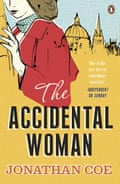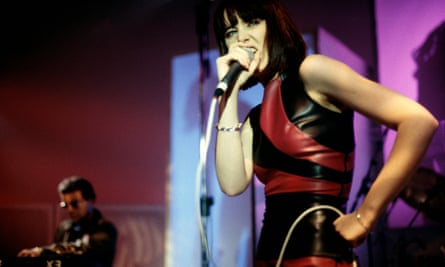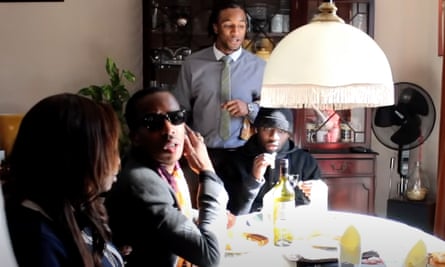Jonathan Coe
The Accidental Woman (1987)
Often, when I’m making a long car journey, I’ll put in the flash drive that contains my whole music library and listen on shuffle. This library also includes some of my own novels on audiobook, so occasionally a chapter from one of my books will pop up between the Ravel and the Sufjan Stevens. When that happens, I’ll skip forward hastily.

But not when it comes to Sophie Ward reading my first published novel, The Accidental Woman. Then, I usually listen, fascinated to think that the 23-year-old who wrote those unfamiliar sentences four decades ago is – in theory – myself. Because it bears no relation to the books I write now. It’s a weird mashup of the novels I was obsessed with at the time (Watt by Samuel Beckett, Christie Malry’s Own Double-Entry by BS Johnson), but with a female protagonist and a hefty dose of British TV sitcom thrown in.
I wrote it in 1984-85, during the second year of my PhD on Henry Fielding at Warwick University. It was handwritten, in four pink exercise books. The original title was Maria and it took 18 months of rejection slips before it caught the attention of the author Alice Thomas Ellis at Duckworth, who persuaded her husband Colin Haycraft to publish it. He paid me a handsome £200 for the world rights and it sold 297 copies in hardback.
Given all that, it amazes me that people are still reading it 40 years later. At a signing session in Thessaloniki recently, a Greek reader presented me with her copy and said it was her favourite of my novels. When I told her it was a peculiar choice, she replied, “Well, I’m a peculiar person.” Sometimes I wish I could find my way back to the distinctively camp, self-parodying voice in which I wrote it (Nigella Lawson, reviewing it for the TLS, called it “studiedly je m’en foutiste”). Sometimes I even think it might be my best novel. But then, I’m quite a peculiar person, too.

Róisín Murphy
Moloko – Do You Like My Tight Sweater? (1995)
I met Mark Brydon at a party in Sheffield having moved there from Manchester. He became my boyfriend on the same night I went to his studio to start Moloko. We left the party to go there and there was no one there because it was the middle of the night. I’d been saying “Do you like my tight sweater?” to a few people and it really worked on him.
Without me knowing, I was starting a music career. I always thought I’d end up doing something visual but instead I went on an adventure with this man who I fell in love with. From the beginning, we both took on the roles of writer and producer. And that was very magnanimous of Mark. Having some 19-year-old come in and tell him not to do this shit and that shit!
Because I was young, I’d spot when something was shite or on its way out or you could see through it. I’d be like that with Mark. Like: “No! Don’t do acid jazz!” or whatever. He really wanted somebody like that to bounce off. People thought he was stupid for falling in love with someone and letting her take over his career, but he wasn’t being stupid. He was being really clever to see the potential in what was there.
I do still listen to it quite regularly because I love it. I think it’s a brilliant record. Mark is one of the best mixers I’ve ever heard. He’s an amazing, forward-thinking drum programmer as well. It’s timeless because it’s got a lot of facets to it. It’s got humour, it’s got feeling, it’s got the exuberance and love of that time. We were creating and we were going somewhere together and I think you can really hear that. It’s joy.
There’s definitely a through-line to whart I do now because my new record also plays with the actor in me and with voices and storylines and not being afraid to go “out there”. It’s also a very funky record and so is Tight Sweater … so there’s a connection. I was very happy when I was making Tight Sweater … and I was very happy when I was writing these new songs.
Róisín Murphy’s new album Hit Parade is out on Ninja Tune on 8 September.

Kiell Smith-Bynoe
Come Dine With Man (2012)
My first work was an all-black spoof of Come Dine With Me. Before that, I’d just done a few little video skits. We did a thing called Teletubbies: Where Are they Now?, which got taken down because we used the original music. There’s a reference in Come Dine With Man that dates it: “Did you get that TV in the riots?” That was the line that got quoted most back to me from the show.
I wrote it with a guy called Ashley J.. We found these guys who were still in film school – there were three cameramen and a sound man. It wasn’t easy putting together a spoof of something really well known that was also different and funny, and we were 24 or 25, trying to make something happen. But eventually, we ended up with something that I’m really happy with. We improvised the whole thing and then structured it so the story would hit certain points. Since then, there hasn’t really been the opportunity to work like that, so it’s a good memory. If you pitch an improv format, people are scared of it. But that’s the background I came from.
It was really stressful, though. We were editing in the house of one of the guys who filmed it – a hotel that his family owned in London’s Baker Street. In between edits, he’d have to go and give room keys to guests who’d just arrived. We really just jumped on the YouTube wave of viral videos. It got good numbers for the time – about 40K on YouTube, which seemed bizarre to us. Videos at the time usually got something like 700 views.

Howardena Pindell
Spray Dot Paintings (early 1970s)
I was originally a figurative artist. I grew up in Philadelphia, which was an intensely conservative city. I’d never seen anything abstract there. The only outrageous work I saw – which I loved – was Marcel Duchamp. There was a very good Duchamp collection.
I was so drawn to the circle. When I was a child, I was with my father in Kentucky at a root beer stand and we were brought two glasses with big red circles on the bottom. And I remember asking my father about the circles and he said it was because of segregation – they had to make sure that those glasses were only used by people of colour, and not by white people.
So I’ve always been trying to reconcile that and tie it in with circles in nature and the sun and moon and planets. In some cases, images from the cosmos appear in the work. My search also brought me to ancient Egyptian art and the use of a large circle over a god or goddess’s head. I’m interested in astronomy and these early works remind me of the denser clusters of stars in galaxies in deep space.
I was in a loft that was only 300 sq feet. I’m amazed now that I created them with such a small set of tools, because they were large. The earlier dot works were more dense. I used a small spray gun – an atomiser. We would attach a plastic jar containing water-based acrylic paint. I had to wear protective equipment because you do not want to inhale it.
I would buy manilla folders and cut them into strips. I moved them around in small sections; that’s the difference between the new ones and the old ones. The old ones were put together on a template and then sprayed a section at a time. They were shown at the AIR gallery, which was a women’s art cooperative I was part of in the 1970s..
It’s my past. The new dot pictures I’ve done recently are like the offspring of the first ones. But back then, I had the energy to climb a ladder. I don’t have that now I’m 80 years old; I have assistants who can do that for me. But I’m still searching.
Howardena Pindell: New Works is at Victoria Miro, London, to 29 July.

Jason Williamson (Sleaford Mods)
Sleaford Mods (2007)
Our first album that was properly recognised by the public was 2013’s Austerity Dogs. But before that, I did four self-released albums as Sleaford Mods without Andrew Fearn, with the self-titled debut in 2007 being the first. I pressed up 50 of each of them and couldn’t get rid of them for love nor money. They’re kind of gold dust now. I’ve got a couple of the originals but they’re in a safe somewhere.
The music was done by the engineer Simon Parfrement. I was working in a warehouse at the time. On Friday afternoons, I’d spend all my wages on drugs and me and Simon would sit in the studio and record these songs. It became clear that I’d stumbled on a good formula. I’d get a series of samples that I thought would fit the lyrics and he’d create the backing music. It wasn’t really collaborative, except in the sense that I didn’t know how to engineer and he did. But he was great – he worked fast. I was sampling the Jam, the Sex Pistols, Roni Size, Barry White, Deep Purple, northern soul, Tim Hardin. We didn’t clear the samples because we didn’t think it would get past the garden gate. So rereleasing it would be absolute madness.
It wasn’t promoted at all; we hadn’t made enough of them for a start. But the guy who pressed them up said: “I really think you’ve got something here.” When you collated a batch of tracks together, it was clear that it worked. There was a mishmash of styles: there’s a lot more singing than on later albums but plenty of the spoken-word, ranty stuff, too.
There’s definitely a line connecting it to what I do now. It was more infantile, though: there were a lot of questionable lyrics – a bit misogynistic and quite blinkered. When Andrew came on board in 2013 I really started to become aware of this. You know: “Why am I referring to a sex worker as a slag?” Andrew’s presence totally transformed it. Up until then, I was very dogmatic and quite narrow-minded. I thought my ideas were the best and everyone else’s didn’t really matter. Bizarrely, I listened to a couple of tracks off the first album about three months ago, on our US tour. And yeah, it’s all right. There’s a track called High Noon that has a nicked hip-hop beat with me singing as near to soul music as I could. There are people who think it’s our best album. I’d say it has its moments.
Stay connected with us on social media platform for instant update click here to join our Twitter, & Facebook
We are now on Telegram. Click here to join our channel (@TechiUpdate) and stay updated with the latest Technology headlines.
For all the latest Music News Click Here
